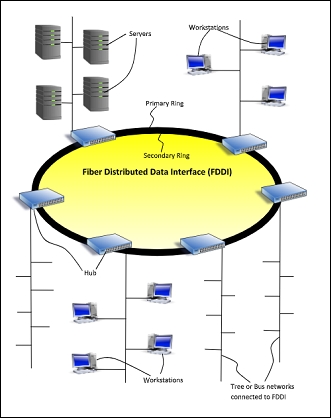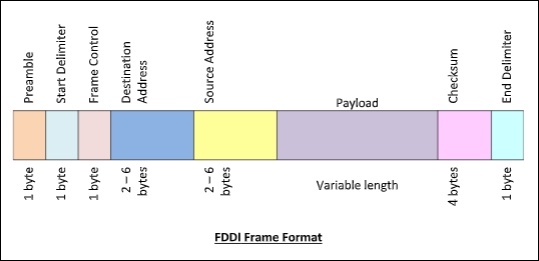
 Data Structure
Data Structure Networking
Networking RDBMS
RDBMS Operating System
Operating System Java
Java MS Excel
MS Excel iOS
iOS HTML
HTML CSS
CSS Android
Android Python
Python C Programming
C Programming C++
C++ C#
C# MongoDB
MongoDB MySQL
MySQL Javascript
Javascript PHP
PHP
- Selected Reading
- UPSC IAS Exams Notes
- Developer's Best Practices
- Questions and Answers
- Effective Resume Writing
- HR Interview Questions
- Computer Glossary
- Who is Who
Fiber Distributed Data Interface (FDDI)
Fiber Distributed Data Interface (FDDI) is a set of ANSI and ISO standards for transmission of data in local area network (LAN) over fiber optic cables. It is applicable in large LANs that can extend up to 200 kilometers in diameter.
Features
-
FDDI uses optical fiber as its physical medium.
-
It operates in the physical and medium access control (MAC layer) of the Open Systems Interconnection (OSI) network model.
-
It provides high data rate of 100 Mbps and can support thousands of users.
-
It is used in LANs up to 200 kilometers for long distance voice and multimedia communication.
-
It uses ring based token passing mechanism and is derived from IEEE 802.4 token bus standard.
-
It contains two token rings, a primary ring for data and token transmission and a secondary ring that provides backup if the primary ring fails.
-
FDDI technology can also be used as a backbone for a wide area network (WAN).
The following diagram shows FDDI −

Frame Format
The frame format of FDDI is similar to that of token bus as shown in the following diagram −

The fields of an FDDI frame are −
-
Preamble: 1 byte for synchronization.
-
Start Delimiter: 1 byte that marks the beginning of the frame.
-
Frame Control: 1 byte that specifies whether this is a data frame or control frame.
-
Destination Address: 2-6 bytes that specifies address of destination station.
-
Source Address: 2-6 bytes that specifies address of source station.
-
Payload: A variable length field that carries the data from the network layer.
- Checksum: 4 bytes frame check sequence for error detection.
-
End Delimiter: 1 byte that marks the end of the frame.

